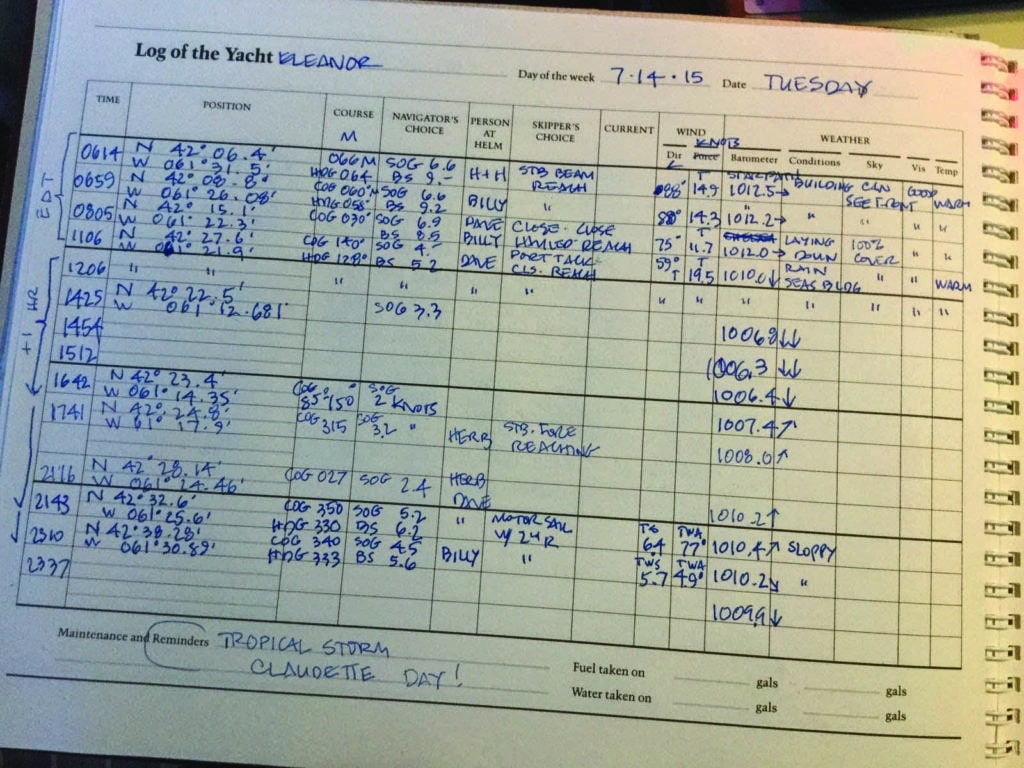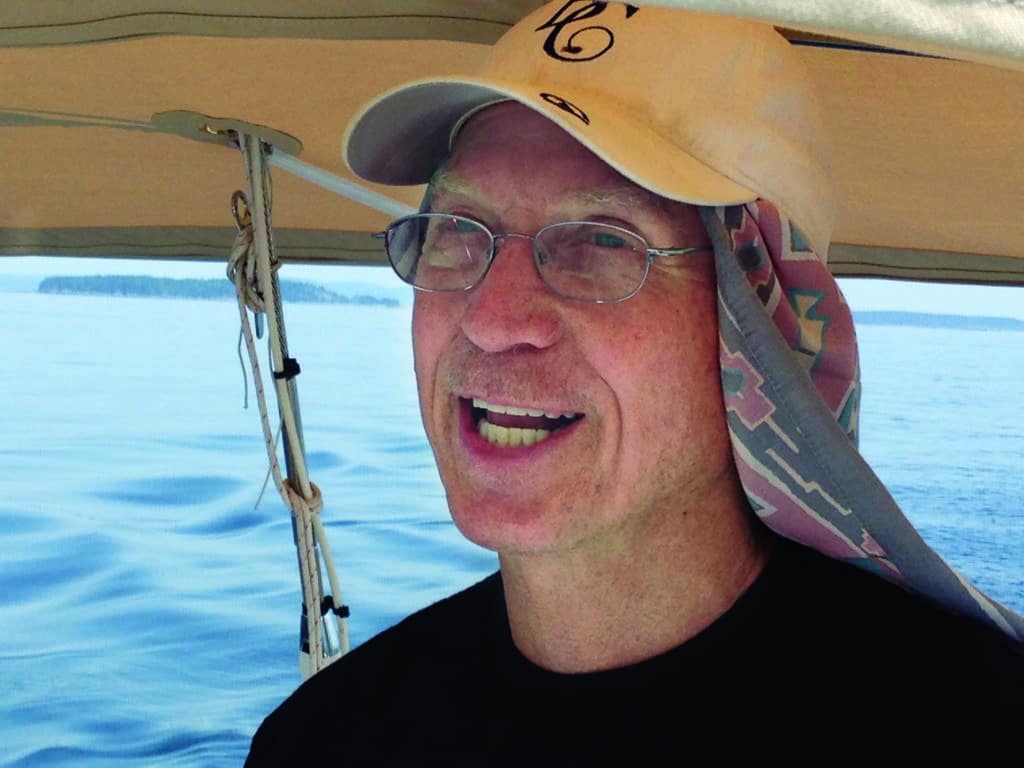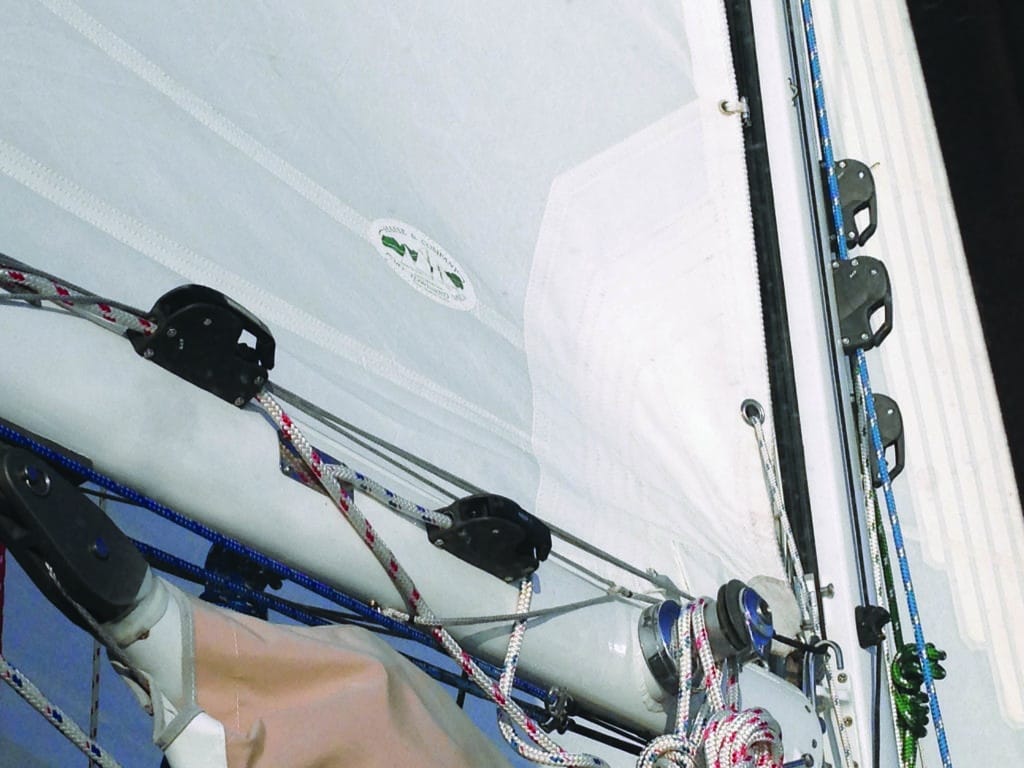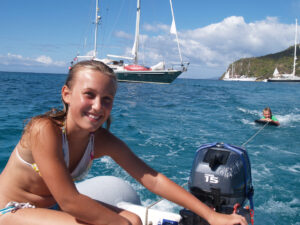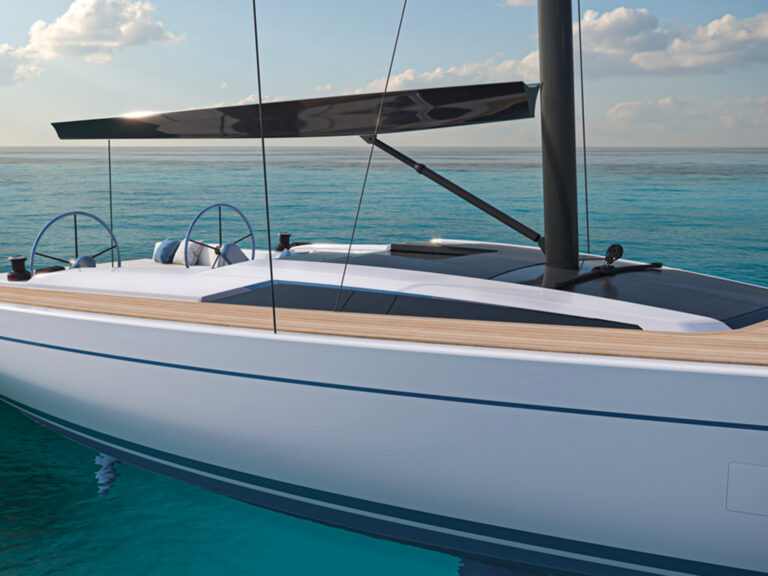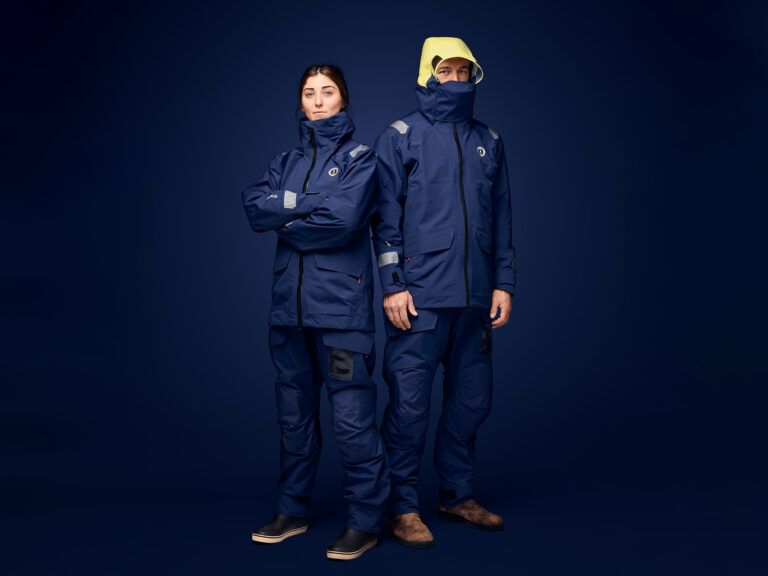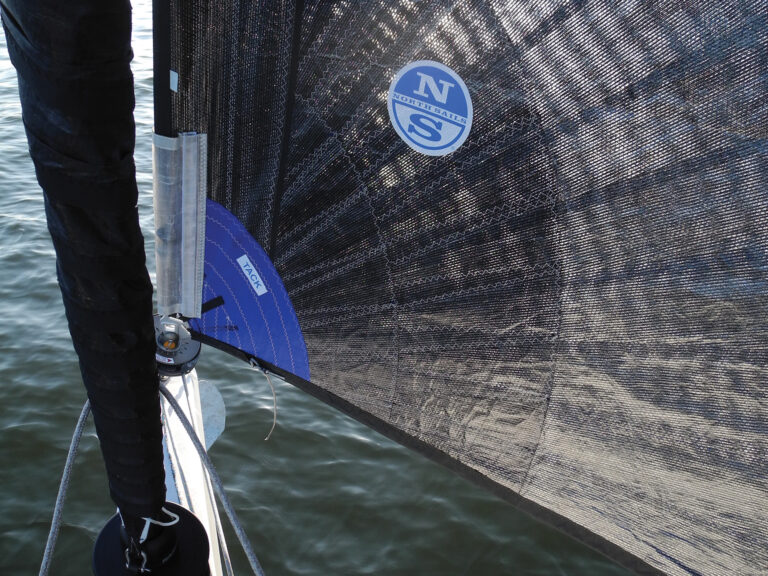Part 4: Tuesday, July 14
It’s not every day you get overrun by a tropical storm you never saw coming. This was our day.
We’d carried the kite through the night. By 0600 Hasse and I were on deck figuring out what to do with it. Rig some snatch blocks to sheet it home further and harden up? Or douse it altogether? A bit earlier, the wind had shifted into the north, and I’d watched the Monitor windvane follow the breeze. This meant we were more or less aimed directly at Sable Island, pleasantly nicknamed “the graveyard of the Atlantic” for the 300-plus ships that had come to grief on its shores.
So we dropped the kite and tacked to gain sea room. It was the first time we’d sailed on port tack the entire trip. Our timing was fortuitous: As soon we cleaned up the foredeck, the breeze banged in at a solid 15 knots.
Logan was stirring, so we fired up the generator and the KVH unit to get fresh weather info from the Internet. And for the second day in a row, we logged on to the Ocean Prediction Center (OPC) page on noaa.gov, which has a wealth of surface analysis maps, text forecasts and other resources. Billy told us he’d arranged for Commanders’ to send Logan and me regular forecasts via email, but we’d yet to receive any. (This, I later learned, was on us; we’d provided erroneous sat-comm email addresses.) The first would arrive, with ironic timing, later that day.
The day before, the OPC had made mention of a weak low approaching from the south, but it didn’t sound like much, with top predicted wind speeds of 20 knots. Today’s written report, from what sounded like a very harried meteorologist, was just confounding: “AM PROVIDING FCST POINTS FOR T.S. CLAUDETTE TO NHC SO WILL BE BRIEF. OFFSHORE FORECASTS MAY BE DELAYED DUE TO CLAUDETTE. OVER THE SHORT TERM ASCAT PASSES MISSED T.S. CLAUDETTE.” ASCAT stands for Advanced Scatterometer, essentially a satellite-based radar system that measures wind speed and direction over the ocean. Of what and where Claudette exactly was, there was no information whatsoever, though the surface analysis map did show the previously mentioned low, now tracking north of our position.
Ho-hum. I’d been up for hours and decided to take a nap.
As it turned out, Claudette was absent from the computer models we’d been accessing. But the National Hurricane Center, where, you know, weathermen — not computer software programs — are watching and interpreting the weather, had issued a report about a developing storm taking shape and heading north a couple of days earlier. By the time we saw that report, it was historical.
Not long afterward I awoke with a start to the violent motion of Eleanor crashing through sharp seas. I glanced around and saw Billy and Hasse in their berths, and looking topsides, I could make out Logan wedged into the leeward cockpit seat. Joining him proved to be an ordeal. To wriggle into my bibs and sea boots, I had to literally lie down on the cabin sole, an exercise that left me slathered in sweat.
“This sucks, Dave,” I said, after finally climbing out the companionway to a wild seascape right out of a Winslow Homer painting, and collapsing onto the opposite settee.
“Welcome to the North Atlantic,” he replied, adding, with a glance at the wind instruments, “Don’t worry. It’s only blowing 12 knots.” Yes, the wind-speed indicator had picked a fine moment to go on the fritz.
We both guessed it was closer to 40 knots, but the real issue was the seaway. After three days of a southwesterly flow, the opposing wave train from the fresh easterly was stacking up slab-sided walls of water that were just ludicrous. Logan invoked a name from our past: the Golfo de Penas, off the coast of Chile, a sensationally miserable piece of water where we’d suffered the single worst night of our entire spin around the Americas. It was déjà vu all over again.
Pretty soon Hasse appeared with some thought-provoking data. She’d brought aboard a Mintaka digital barometer provided by David Burch of Starpath Navigation, under whom she’d started studying advanced meteorology; Logan had got the instrument operational about 48 hours earlier. The device displayed pressure trends with helpful arrow icons. One arrow straight up, for instance, showed pressure rising fast. One arrow going down was pressure falling. Two arrows down represented present or imminent danger — the onset of Armageddon. Both arrows, she said, were pointed in that direction. The accompanying bar graph looked like a chart of the Chinese stock market. It was plunging.
At the moment, going forward to shorten sail further would’ve been a pretty athletic endeavor, so we were stuck with a single-reefed main and staysail. Hasse suggested heaving to; once we’d tamed the bucking bronco, we reckoned we could reef or strike the main altogether, and run up the storm trysail and/or staysail. So we tacked and backed the jib, which almost instantly eased the motion. But it still wasn’t wonderful, so we tried it again, on the opposite board, which was much, much better. It wasn’t your classic heaving-to maneuver; we were actually fore-reaching, making 4 knots over the ground — 2 to weather, and 2 sort of skidding sideways down the waves. But we’d definitely stabilized the situation and felt no need to alter the sail plan.
Hasse decided to call Burch, back in Seattle, to get his take on the matter. She used my iPhone with the Iridium Go!, and Burch picked up almost immediately. Hasse had accidentally hit the speaker button on the phone, so Logan and I could hear both ends of their conversation. When Hasse explained the barometer had dropped 6 millibars in six hours, Burch cried, “That’s a weather bomb!” Logan blinked twice, which is as emotional as I’d ever seen the man. Hasse gave Burch our coordinates, and he said to sit tight; he’d be back to us shortly.
When he called back, he informed us Tropical Storm Claudette was right now overrunning us. “But you’re on the navigable side of it, away from the dangerous semicircle,” he said. Plus, it was tracking northeast and away from us, quickly. It wasn’t long at all before the barometer once again began an upward trajectory, and everything else sort of mellowed out.
It was right about then that I got a text from my sister, channel-surfing from her couch back in Rhode Island: “Is Tropical Storm Claudette going to bother you? It looks like it’s headed right where you are.” When your offshore updates are coming from The Weather Channel, you’re definitely in trouble.
So now what?
There were some new developments aboard Eleanor. The dripless shaft coupling was now dripping. We had leaks in the on-deck Charlie Noble vent for the heater and the mast boot. “We have water coming in from the top and the bottom,” noted Logan. Our comms were still iffy; our success rate locking onto satellites was about 50 percent. The manifold system for the fuel tanks had been a problem from the start, and now a strong smell of diesel permeated the main cabin.
On top of that, from Burch and a subsequent call to Commanders’ (following an email they’d sent during the tropical storm to inform us we were in a tropical storm), we had a reliable extended forecast that was pretty sporty, with a series of small gales lined up for the next several days. Commanders’ called it “a very active weather pattern for midsummer.”
Billy had joined us in the cockpit, and we convened a team meeting. We each said our piece. Nobody’s a better boat wrangler than Logan, and it was very clear his level of frustration was high, and growing. He was tired of rebuilding the boat underway. Hasse pointed out that if we kept going, our progress could be very slow in the coming days, well under the daily 150-mile runs we needed to make to keep to everyone’s schedules. And it was pretty clear to me that if we did press on, and things went totally sideways in the mid-Atlantic, we could be in a world of hurt. Billy didn’t say much, but it seemed we’d already reached a quorum.
That was that. The transatlantic attempt was over. We altered course for Halifax.
Herb McCormick is CW’s executive editor and the author of As Long As It’s Fun, the award-winning biography of Lin and Larry Pardey.
